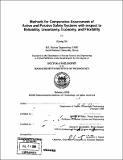| dc.contributor.advisor | Michael W. Golay. | en_US |
| dc.contributor.author | Oh, Jiyong | en_US |
| dc.contributor.other | Massachusetts Institute of Technology. Dept. of Nuclear Science and Engineering. | en_US |
| dc.date.accessioned | 2009-03-16T19:42:18Z | |
| dc.date.available | 2009-03-16T19:42:18Z | |
| dc.date.copyright | 2008 | en_US |
| dc.date.issued | 2008 | en_US |
| dc.identifier.uri | http://hdl.handle.net/1721.1/44782 | |
| dc.description | Thesis (Ph. D.)--Massachusetts Institute of Technology, Dept. of Nuclear Science and Engineering, 2008. | en_US |
| dc.description | Includes bibliographical references. | en_US |
| dc.description.abstract | Passive cooling systems sometimes use natural circulation, and they are not dependent on emergency AC power or offsite power, which can make designs simpler through the reduction of emergency power supplying infrastructure. The passive system approach can lead to substantial simplification of the system as well as overall economic benefits, and passive systems are believed to be less vulnerable to accidents by component failures and human errors compared to active systems. The viewpoint that passive system design is more reliable and more economical than active system design has become generally accepted. However, passive systems have characteristics of a high level of uncertainty and low driving force for purposes of heat removal phenomena. These characteristics of passive systems can result in increasing system unreliability and may raise potential remedial costs during a system's lifetime. This study presents a comprehensive comparison of reliability and cost taking into account uncertainties and introduces the concept of flexibility using the example of active and passive residual heat removal systems in a PWR. The results show that the active system can have, for this particular application, greater reliability than the passive system. Because the passive system is economically optimized, its heat removal capacity is much smaller than that of the active system. Thus, functional failure probability of the passive system has a greater impact on overall system reliability than the active system. Moreover, considering the implications of flexibility upon remedial costs, the active system may more economical than the passive system because the active system has flexible design features for purposes of increasing heat removal capacity. | en_US |
| dc.description.statementofresponsibility | by Jiyong Oh. | en_US |
| dc.format.extent | 184 leaves | en_US |
| dc.language.iso | eng | en_US |
| dc.publisher | Massachusetts Institute of Technology | en_US |
| dc.rights | M.I.T. theses are protected by
copyright. They may be viewed from this source for any purpose, but
reproduction or distribution in any format is prohibited without written
permission. See provided URL for inquiries about permission. | en_US |
| dc.rights.uri | http://dspace.mit.edu/handle/1721.1/7582 | en_US |
| dc.subject | Nuclear Science and Engineering. | en_US |
| dc.title | Methods for comparative assessment of active and passive safety systems with respect to reliability, uncertainty, economy, and flexibility | en_US |
| dc.type | Thesis | en_US |
| dc.description.degree | Ph.D. | en_US |
| dc.contributor.department | Massachusetts Institute of Technology. Department of Nuclear Science and Engineering | |
| dc.identifier.oclc | 300300707 | en_US |
